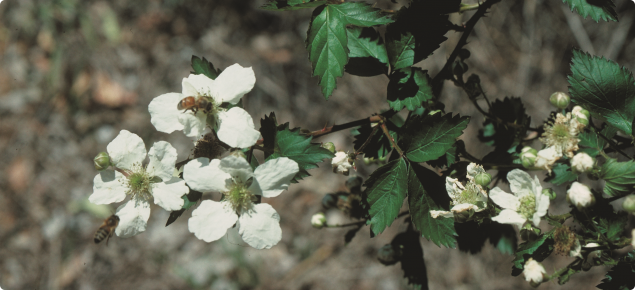Information about this pest can be found on the blackberry: declared pest page.
Login or set up a new account on DPIRDs online training site to access:
- a training course on how to identify early blackberry and report it.
- training material that you can use to teach community groups how to identify early blackberry.
Chemical requirements
When using any agricultural chemicals please ensure that you always follow instructions on the label and any permit. Users of agricultural chemical products must always strictly comply with the directions on the label and the conditions of any permit. To view permits or product labels go to the Australian Pesticides and Veterinary Medicines Authority website.
Chemical control options
Chemical control options can be found below. For other methods of control please refer to the declared plant control handbook.
Recommended herbicides | December to April - flowering to fruit maturity:
|
| Herbicide: Triclopyr (Group I) (various trade names: see APVMA link) | |
| Active ingredient | 600g/L triclopyr |
| Rate of dilution for spot spraying Product /10L water |
|
| Rate of product/ha | Not recommended |
| Wetting agent | 1:400 plus summer spraying or crop oil at 1% may be useful |
| Time of application | Flowering to fruit maturity usually from December-April |
| Remarks | Rate varies with age of cane and density of absorptive surface:
In conjunction with spray treatment: burn or slash dead canes in spring: encourage heavy grazing of regrowth: respray regrowth in summer. |
| Herbicide: Triclopyr +picloram (Group I) (various trade names: see APVMA link) | |
| Active ingredient | 300g/L triclopyr + 100g/L picloram |
| Rate of dilution for spot spraying | 350–500mL/100L water |
| Amount of product/10L water | 35-50mL |
| Rate of product/ha | Not recommended |
| Wetting agent dilution | 1:400 plus summer spraying or crop oil at 1% may be useful |
| Time of application | Flowering to fruit maturity usually from December-April |
| Remarks | Spray 1-2m strip around edge of infestation to help control suckering:
Use the higher rate where plants have been damaged by grazing stock or insects. |
| Herbicide: Glyphosate (Group M) (various trade names: see APVMA link) | |
| Active ingredient |
Other concentrations of glyphosate available |
| Rate of product/10L water |
Adjust rates for other concentrations of glyphosate |
| Wetting agent dilution | Addition of Pulse @ 1:500 may give faster kill |
| Rate of product/ha | Not recommended |
| Time of application | December to April |
| Remarks |
|
| Herbicide: Metsulfuron (Group B) (various trade names: see APVMA link) | |
| Active ingredient |
|
| Rate of dilution for spot spraying | 10g/100L for the 600g/kg formulation |
| Rate of product/10L water | 1g |
| Rate of product/ha | Not recommended |
| Wetting agent dilution | 1:400 |
| Time of application | December – April |
| Remarks |
|
| Herbicide: Glyphosate (Group M) + metsulfuron (Group B) (various trade names: see APVMA link) | |
| Active ingredient | 360g/L or 700g/kg glyphosate + 600g/kg metsulfuron methyl |
| Rates of dilution for spot spraying |
|
| Rate of product/ha | Not recommended |
| Wetting agent dilution | Pulse 1:500 or 0.2% (200mL/100L) |
| Time of application | December - April |
| Remarks |
|
| Herbicide: Trounce® Brush-Pack™ herbicide | |
| Active ingredient | 10g/kg metsulfuron (Group B) + 835g/kg glyphosate (Group M) |
| Rate of dilution for spot spraying | 173g (1 pack)/100L |
| Wetting agent dilution | Pulse 1:1000 or non-ionic @ 1:400 |
| Time of application | Flowering to start of leaf yellowing |
| Remarks |
|
Recommendations for blackberry control
- Results have shown that it is best to first apply glyphosate or metsulfuron or a mixture of both to substantially reduce the area of the infestation then treat any remaining plants the following seasons with picloram + triclopyr treatments.
- It is not recommended to use the picloram + triclopyr treatment first, as follow up applications of metsulfuron or glyphosate are not as effective as when used first. In addition the cost of the picloram + triclopyr is considerably greater than the metsulfuron.
- The use of glyphosate is also more expensive than the metsulfuron and can leave the ground bare of vegetation for some time allowing a substantial germination of blackberry seedlings.
- Using only metsulfuron leaves other plants to cover the area and discourages the germination and competes with the blackberry seedlings.
- The addition of 1% oil to the spray also improves the control. All declared species of blackberry are controlled using the suggested herbicides.


